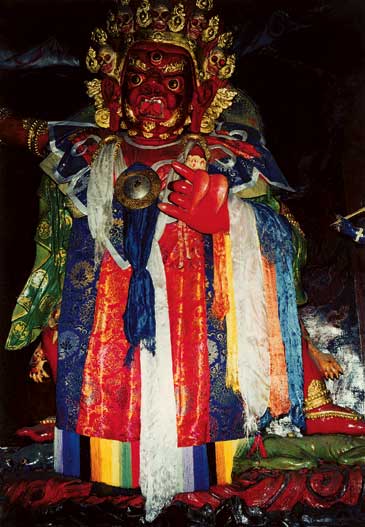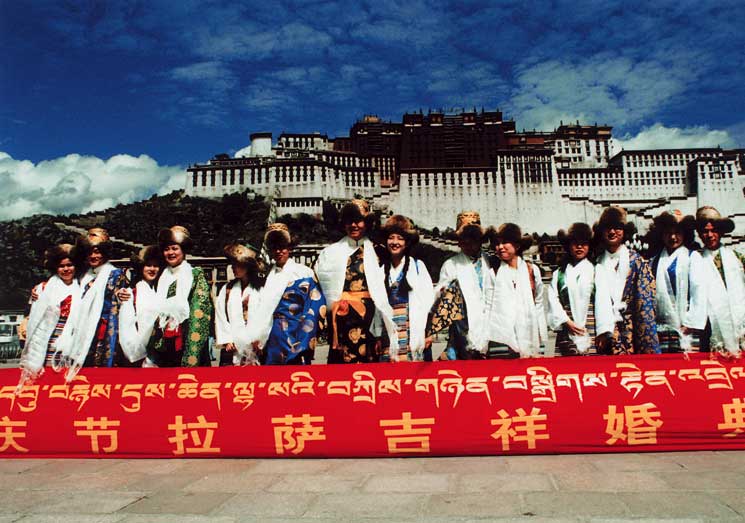Hada is a Tibetan word meaning silks in Tibetan language. It is traditionally used as a ritual fabric presented to the statues of Buddha, Living Buddhas, any revered person or VIP, and during wedding or funeral ceremony.
In Tibet today, however, hada is used in an extensive way, including celebrations and horse races. In the Tibetan-inhabited areas in Qinghai and Tibet, when one leader comes for an inspection, no posters will be put up to greet him. Instead, he will be presented with hada as a token of welcome.

Where Does Hada Come From
The Tibetan race worships white color, believing it symbolizes purity, auspiciousness, sincerity, kindness, justness and prosperity. Because of this belief, they leave white stones on a Mani stone mound, tie white sheep wool around an arrow, and place white sheep wool at the door....
When the Tibetans had no access to silks, they used animal hide and sheep wool as gifts and awards by tradition. Article 15 of the regulations promulgated by Tubo King Songtsan Gambo stipulates use of tiger hide as an award to heroes. During the period of the 9th Tsampo Degonggyi, followers of the Bon religion tied their heads and necks with sheep wool during rituals.
Later on, there were people who wove fabrics with sheep wool. Herein lies the source of hada.
In the 12th century, Pagba brought silk fabrics from Dadu of the Yuan Dynasty to Tibet, presenting them as gifts to statues of Buddha in major monasteries, and to monk officials.
Legend has it that, when Pagba was presenting hada to statues of Buddha, Tara in a mural reached out her hand demanding one piece.
Using hada for ritual purpose became increasingly popular during the period of Zongkapa. The Mongolian and Tu ethnic groups, who believed in Tibetan Buddhism, adopted the form of ritual.
Raw Materials Used to Make Hada
White is the chief color of hada. In the Tibetan-inhabited areas where Buddhism flourished, hada is of diversified colors, with white color for hada for the Goddess of Mercy, yellow for the Wisdom Buddha and dark blue for the Diamond Hand.
Later, four colors were in vogue yellow representing earth, white representing water, red representing fire and black representing wind. Later, blue representing the sky was added. However, black hada were seldom seen, and whenever there is the need to present one, dark blue is used instead.
Patterns on hada include clouds, eight treasures, and words including happiness and longevity.
Materials used to make hada include silks, yarns and white ramie. At first, materials from Nesangma and Guanqu Qenma were adopted to make top quality hada, those from Nyidema and Dunkoma to make second-class ones, and materials from Chenlaida Gyima, Ngaxi, Soixi, Xizun and Soinam to make third-class ones.
Take white hada for example. It is divided into Neku, Ngaxi and Soixi hada. The first was made of fabrics from the imperial warehouse. It is divided into four kinds including auspiciousness,'' happiness,'' harmoniousness'' and longevity''. Its rim was embroidered with patterns of city walls, its center with a right-turning conch, its upper and lower parts with two dragons playing with a pearl, and its left and right sides with a swastika.
Hada presented to statues of Buddha come of blue, white, red, green and yellow color, with blue symbolizing the sky and river waters, white representing clouds, red showing Buddhist guardians and yellow representing the earth.

Rituals for Presenting Hada
The Tibetan race clearly cherishes hada. As a result, they have developed ways unique to themselves to present hada to show their respect. The prevalent way is to fold a hada with the folding line facing the presenter, and then present it with both hands.
The white color of a hada shows purity of mind and its length represents ever-lasting relationship.
In the past, the Gaxag government followed a strict rule in using hada. Generally speaking, Neku hada was not used unless on the second day of the first Tibetan month when Galoon officials and the secretary of the secretariat had to present them to the Dalai Lama. On ordinary occasions, when the Dalai Lama met with them, they presented Ngaxi hada only.
Rituals to Present Hada. Various officials adopted different classes of hada to match their respective official positions.
--Civilians adopt hada in accordance with their respective economic situation.
--When presenting a hada to a Living Buddha or one of the older generation, the presenter needs to bow at an angle of 90 degrees, raise the hada above the head with both hands, and leave it draped over the hands of the recipient or a place it in front of the seat of the recipient.
--When a hada is presented to one riding on a horseback, it needs to be draped over the hands or wrists of the recipient.
--When a hada is presented to one lower than the presenter in generation or official ranking, the hada may be draped around the neck or on the arms of the recipient.
--A departing guest will leave behind a hada on his seat meaning “thank you for your generous reception” or “I am leaving but you will always be in my mind”.
--In Xigaze Prefecture, people there follow a way in presenting hada different from in other parts of Tibet. Generally, the hada will be placed around the recipient from front to the back.
